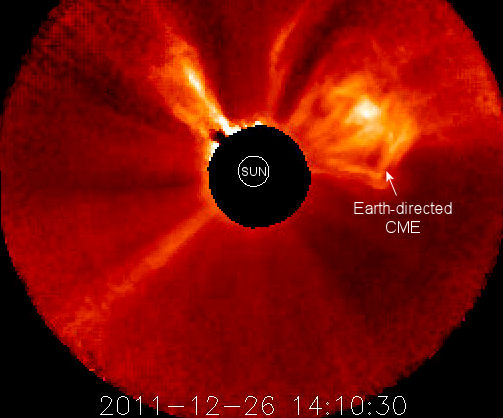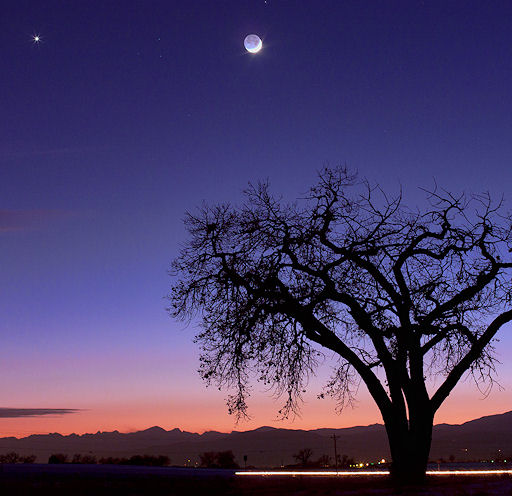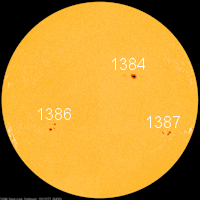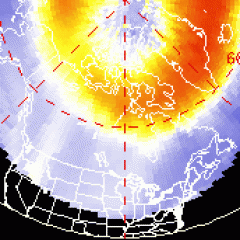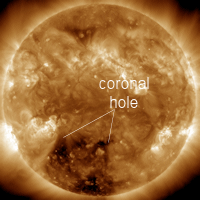~Space Weather Update~ Two CMEs toward Earth in less than 24 hours. [1]
~Space Weather Update~ Two CMEs toward Earth in less than 24 hours.
MORE SUNSET PLANETS: On Dec. 27th, for the second night in a row, Venus and the crescent Moon are lining up in the western sky for a beautiful sunset conjunction. Go outside when the sun goes down and enjoy the show. (Scroll past the CME for scenes from Dec. 26th.)
CMEs TARGET EARTH, MARS: The odds of a geomagnetic storm on Dec. 28th are improving with the launch of two CMEs toward Earth in less than 24 hours. NASA's STEREO-B spacecraft photographed this one on Dec. 26th:
According to a forecast track [3] prepared by analysts at the Goddard Space Weather Lab, the cloud should squarely strike Earth's magnetic field on Dec. 28th at 20:22 UT (+/- 7 hours). Another CME could deliver a glancing blow a few hours earlier on the same date. The double impact is expected to spark mild-to-moderate geomagnetic storms at high latitudes. Aurora alerts: text [4], voice [5].
Mars is also in the line of fire. The first of the two CMEs is squarely directed toward the Red Planet [6]--estimated time of arrival: Dec. 30th at 1800 UT. Using onboard radiation sensors, NASA's Curiosity rover might be able to sense the CME [7] when it passes the rover's spacecraft en route to Mars.
VENUS AND THE MOON: On the night after Christmas, the heavens delivered a belated present--a conjunction of Venus and the crescent Moon. Robert Arn sends this picture from Fort Collins, Colorado:
"I arrived at the observing site a few minutes before sunset," says Arn. "Minutes after the sun disappeared behind the mountains I saw a very slender moon pop out of the cold, crisp sky. Soon, Venus joined the show. Over the next two hours I watched the sky turn hundreds of shades of blues, pinks, purples, and blacks as the two heavenly bodies slowly crept across the sky."

![]()
Solar wind
speed: 243.3 km/sec
density: 0.7 protons/cm3
explanation [9] | more data [10]
Updated: Today at 1426 UT
![]()
X-ray Solar Flares
6-hr max: C6 1207 UT Dec27
24-hr: C8 0422 UT Dec27
explanation [11] | more data [12]
Updated: Today at: 1400 UT
![]()
![]()
![]()
Daily Sun: 27 Dec 11
![]()
![]()
Sunspots 1386 and 1387 have "beta-gamma" magnetic fields that harbor energy for M-class [14] solar flares. Credit: SDO/HMI
![]()
![]()
![]()
Sunspot number: 110
What is the sunspot number? [15]
Updated 26 Dec 2011
Spotless Days
Current Stretch: 0 days
2011 total: 2 days (<1%)
2010 total: 51 days (14%)
2009 total: 260 days (71%)
Since 2004: 821 days
Typical Solar Min: 486 days
Updated 26 Dec 2011
The Radio Sun
10.7 cm flux: 146 sfu
explanation [16] | more data [17]
Updated 26 Dec 2011
![]()
![]()
![]()
Current Auroral Oval:
![]()
Switch to: Europe, USA, New Zealand, Antarctica
Credit: NOAA/POES
![]()
![]()
![]()
Planetary K-index
Now: Kp= 0 quiet
24-hr max: Kp= 0 quiet
explanation [19] | more data [20]
![]()
Interplanetary Mag. Field
Btotal: 3.3 nT
Bz: 2.5 nT north
explanation [21] | more data [22]
Updated: Today at 1426 UT
![]()
![]()
![]()
Coronal Holes: 27 Dec 11
![]()
![]()
A solar wind stream flowing from this coronal hole could reach Earth between Dec. 29th and 30th. Credit: SDO/AIA.
Category:
- Ground Crew Updates [24]
